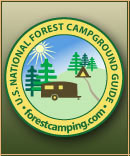Forest Information
The Kootenai National Forest is located in the northwest corner of Montana, bordered on the north by Canada and Idaho on the west. The Forest is comprised of 1,778,064 acres in Montana and 46,480 acres in Idaho. There are thirty-eight developed campgrounds of which twelve met the selection criteria. None of the campgrounds in Idaho met the criteria.
The Kootenai National Forest has a history of logging but, today, fields of old tree stumps are replaced by the velvet green of young Douglas-fir. Evidence of the by-gone days of mass logging operations are gone, except for Forest Service maintained logging roads and a few preserved log flumes. The Forest is returning to its former lush condition. Enjoying the benefits of a healthy forest are robust populations of elk, deer, black bear, mountain sheep, mountain goat, and moose. Found in the rugged heights of the Cabinet Mountains Wilderness down to the lower elevation along of the Clark Fork River, wildlife is everywhere and often seen by Forest visitors.
A wonder of engineering can be found in the Forest - the Libby Dam. The Dam is 422 feet tall, stretches 3,055 feet from bank to bank, and forms the 90-mile long Lake Koocanusa (koo-ca-nusa). An Army Corps of Engineer's project, the Libby Dam was built to provide flood protection and hydroelectric power to northwest Montana. The Dam also provides some record-size fishing opportunities. Rainbow, Cutthroat and Brook trout, Kokanee salmon, Whitefish, and Kamloop can be found behind the Dam in the clear waters. Along with excellent fishing, bird watchers should enjoy the osprey and Bald Eagle sightings.
Behind the Dam, Koocanusa Lake reaches into Canada and offers outstanding boating opportunities. The Forest Service has various levels of camping locations around the lake for use by both campers and boaters. Only the developed camping locations are included in this campground review. Rexford Bench is the most developed and largest of the campgrounds, with a large swimming beach, boat ramp area, and sites for recreational vehicle (RV) and motorhome camping enthusiasts. McGillivray, the only family campground along the lake's western shore, is set deep in thick woods and also has a swimming beach and pleasant car and tent camping sites. Peck Gulch and Rocky Gorge campgrounds are maybe one step removed from dispersed campgrounds. These campgrounds offer very basic services with mostly parking lot style camping with few designated individual sites (and did not meet our selection criteria). Offering easy access to the water, Peck Gulch and Rocky Gorge are favorites of boaters.
Water is not the only attraction to bring people to the Libby Dam area. A most unusual sign, found along the eastern side of the lake on the Scenic Highway, gives and identifies another popular sport enjoyed by landlubber. About mid-point along the eastern portion of the Highway is a collection of rock faces known as Stone Hill. These giant rock buttresses are a mecca for beginning to expert climbers. You will know it is Stone Hill when you see the "Falling Rock climbers" sign.
Although the Kootenai Dam and Reservoir complex is spectacular, perhaps the best parts of the Kootenai National Forest are not as visible from the roadway. Places like Ross Creek Cedar Grove, Libby Creek Gold Panning Area and Big Therriault Lake Loop Trail provide a glimpse into the Forest's less seen delights.
Ross Creek Cedar Grove, a short drive west of the Bad Medicine campground, is a 100-acre scenic area featuring a stand of old-growth cedar trees. A leisurely 0.9 mile walk winds through the grove, past 175 foot tall cedars, and beside an alpine lake fed stream. Some of the trees have been given fanciful names like "Wrestlers," "Fairy Den," and "Cedar Chimney." Such names add to the magic of Ross Creek Cedar Grove.
Pristine Howard Lake is a very long drive down a rather dusty road. But the reward is a sweet little campground and the chance to pan for gold, the old-fashion way, in Libby Creek. The history of gold prospecting along the Libby goes back to 1867. Mining on the Creek hit its peak from 1889 to 1909. The gold found today is basically overlooked or left behind by the earlier dredging methods. It is estimated 10 to 15% of the original gold remains so the odds are fair for the fledgling or expert gold panning prospector.
With 1400-miles of trails throughout the Kootenai, including five National Recreation Trails, there must be a trail to everyone's taste. Perhaps the most beautiful trail is a stone's throw from Canada and adjacent to the Big Therriault (TEAR-ee-ot) Lake campground. The Big Therriault Lake Loop Trail encircles this gorgeous alpine lake, winding through woods, past sweet scented pines, through clouds of many colored wildflowers, and across a lush meadow. The blue sky is separated from the lake's teal colored surface by the dark green pines.
Passing through the southern portion of the Kootenai National Forest is the scenic State Route 200. North Shore and Bull River campgrounds are convenient for the transit campers. However, once there the camper may discover these campgrounds make delightful vacation spots. With some excellent Smallmouth bass fishing at the former and a nice variety of fish at the latter, folks tend to come back for another chance at "the big one."
Whether enjoying the spectacular Koocanusa Reservoir with its Kokanee salmon and outstanding boating opportunities, or the quiet beauty of a small, pristine alpine lake, the Kootenai National Forest is a delightful forest to visit.
ADDRESSES
SUPERVISOR ADDRESS
31374 US Hwy. 2
Libby, Montana 59923
406-293-6211
RANGER DISTRICT ADDRESSES
Cabinet
2693 Hwy. 200
Trout Creek, Montana 59874
406-827-3533
Libby
12557 Hwy. 37
Libby, Montana 59923
406-293-7773
Rexford - Fortine
949 US Hwy. 93N
Eureka, Montana 59917
406-296-2536
Three Rivers
12858 US Hwy. 2
Troy, Montana 59935
406-295-4693 |
